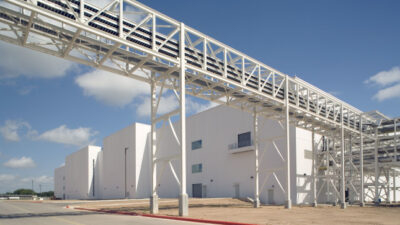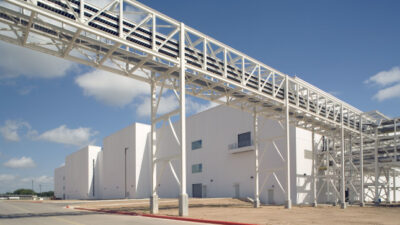Although the overall R&D facilities market is somewhat slowing down, a number of R&D markets remain hot and are driving a new generation of high-tech, energy-efficient, amenity-packed laboratories. Leading the R&D charge is biotech, nanotechnology, bio-fuels, bio-safety and alternative energy research.
Although the overall R&D facilities market is somewhat slowing down, a number of R&D markets remain hot and are driving a new generation of high-tech, energy-efficient, amenity-packed laboratories.
Leading the R&D charge is biotech, nanotechnology, bio-fuels, bio-safety and alternative energy research. On the funding side, academia remains strong and corporate is flat, while government expenditures are in flux.
“All and all, I think it’s a robust market,” observes Scott Butler, P.E., president, CUH2A, Princeton, N.J. “Although the expected flood of products from biotech has been limited, it certainly remains a strong R&D market.”
“Genome research is still receiving massive grants,” concurs Ronald Regan, P.E., president, Triad Consulting Engineers, Morris Plains, N.J. “There is much hope that research will lead to a big breakthrough in the future.”
At the same time, many pharmaceutical companies are taking a hard look at their R&D operations due to lower stock values, mergers and a lack of innovative products coming to market, according to J.C. Messina, principal, PWI Engineering, Philadelphia. Consequently, M/E firms are seeing more adaptive reuse and renovation work in this area, as opposed to new greenfield projects.
As far as government R&D dollars, the main focus has been on homeland security, i.e., building bio-containment labs around the country, as well as promoting alternative energy research, particularly at the state level, in response to heightened sensitivities to the world’s diminishing oil supply and global warming, according to Steve Frei, P.E., LEED AP, principal and head of Affiliated Engineers’ science and technical practices group, Madison, Wis.
| One trend in the R&D industry is the installation of programs such as Labs21, which has provided a lab rating system similar to the U.S. Green Building Council’s LEED; building owners and designers are being provided with more tools and |
A shrinking workforce and limited funding has pushed institutions to build cutting-edge laboratories offering a variety of amenities to attract top-notch researchers, and the grant money that usually follows behind these folks.
For example, “R&D companies are selecting sites near large, popular east coast cities, such as Boston, Philadelphia, New Jersey and North Carolina’s Research Triangle Park,” says Thomas A. Bathgate, P.E., PWI’s president and principal. “From the design/facility perspective, we are seeing an interest in daycare, nearby athletic/wellness centers, excellent break room facilities and cafeteria services.”
Cross-discipline work
Also in vogue is altering the architecture and spatial planning to support increased cross-discipline collaboration.
“There is an effort to take people out of their silos to encourage them to come up with cross-discipline solutions and to find those flashes of innovation,” Butler explains.
Consequently, offices are being placed next to laboratories. Departments, previously separated by different floors or buildings, are now being brought together. With break-out spaces, lounge areas and coffee bars strategically placed within the vicinity, these researchers are provided with greater opportunities to come together and exchange ideas.
At the same time, Jeff Murray, director of research and corporate facilities, IDC Architects, Pittsburgh, a subsidiary of CH2M Hill, points out, “Social interaction spaces are seen as more effective if less formal, more dispersed and properly located in the flow of everyday circulation.”
In addition to increased collaboration among scientists, a greater integration between research facilities and their surrounding communities also has been a growing trend, Butler says. These facilities are proactively communicating with their neighbors regarding the nature of research going on inside the facility and the safety measures that are being employed. Similarly, transparent designs are beginning to be utilized in order to provide community members with a view inside.
The pursuit of saving energy
Probably one of the biggest trends—now more than ever—in the R&D industry is the installation of energy-efficient building systems. And with programs such as Labs21, which has provided a lab rating system similar to the U.S. Green Building Council’s LEED, building owners and designers are being provided with more tools and encouragement in this realm.
| Source: CRB, |
In addition, standards such as ASHRAE 90.1 have set a goal of achieving 30% greater efficiencies from 2007 to 2010, while the federal government would like to see a 50% decrease in energy consumption from 2000 to 2015.
“A 30% reduction in energy is possible with most existing technology, but achieving 50% will require a culture shift in the industry toward integrated building design,” explains Kent W. Peterson, P.E., FASHRAE, vice president and chief engineer, P2S Engineering, Long Beach, Calif.
Perhaps one of the first places to start is by reducing fan energy and airflow rates, because these drive the largest energy consumption in laboratories today. In addition to utilizing variable air volume hoods, zone presence sensors reduce face velocities 40% when objects are not detected in front of the hood. Strategies for reducing static pressure in both the supply and exhaust systems include manifolding compatible exhaust systems, sizing air handler coil face velocities for below 400 fpm and operating redundant air handlers in parallel to reduce overall fan energy.
As far as the HVAC goes, Peterson suggests considering air change resets at night. Also, by oversizing ductwork, this helps reduce the supply air and exhaust static pressure. Another approach is strategically exhausting high heat load equipment at their source of heat rejection. “This creates less of an impact on the AC system, thereby reducing the cooling load.”
Chilled beams, which already have been in use in Europe for some time now, have started gaining popularity in the United States, providing engineers with another energy-saving mechanism. The beams utilize chilled water systems, which run above the dew point to create a cooling effect without having to recirculate air around the buildings.
Garrett Nariman, P.E., LEED AP, electrical engineer, The RMH Group, says that vulnerability of equipment to voltage surges, harmonics and grounding issues is a concern. “After a thorough review of equipment requirements, a number of strategies are employed such as harmonic canceling transformers, tuned filters, surge protective devices and a variety of grounding components.”
Of course, it goes without saying that continuity of power is a high priority item. “An unplanned outage often can destroy weeks of research and potentially damage test equipment,” Nariman says.
Consequently, there has been an explosion in the quantity of backup power equipment being installed. “Everyone, small to big, is looking for 100% standby generation. In 40 years, I haven’t put in as many generators for non-emergency service as I have in the past year,” Regan says.
| Source: CRB, |
Top security
On the topic of security, a big concern is preventing leaks of proprietary research. Thus, the high-tech security gadgetry formerly used by government agencies such as the FBI and CIA, is now making its way into mid- to large-sized R&D facilities, Regan says.
Devices such as thumbprint readers and retinal scans are being employed. Building owners also are putting more effort into better segregating the manufacturing and warehouse sections of their facilities from the R&D laboratories, Tunnell adds.
“Another [security] trend is IP-based CCTV systems,” Nariman offers. “This approach results in more economical, better organized and more flexible monitoring of R&D facilities. It is achieved because the cabling is designed and installed as a part of the building’s structured cabling, instead of as an ‘after the fact’ add-on to the building, as it typically has been done.”
And with the cost of smart cards decreasing, they are starting to replace older Prox card technology. Of course, the advantage of smart cards is that they can be employed, beyond access control, for applications such as cafeterias, lending libraries and lab equipment tracking, Nariman adds.
Looking forward
While research funding, in some areas, remains uncertain, the overall drive to remain competitive and drive innovation is likely to ensure a generally positive growth trend for the R&D industry in the U.S., as long as the economy supports it.
In the meantime, it behooves designers to keep up with the latest in energy-efficient systems as this will continue to be a priority for laboratories moving forward.
LEED and Labs
With a big focus on energy efficiency in today’s R&D facilities, seeking LEED certification isn’t too far behind.
“Sustainability appears on almost everyone’s agenda, even if they don’t ultimately go for LEED,” observes Kent W. Peterson, P.E., vice president and chief engineer, P2S Engineering, Long Beach, Calif.
As a general point of reference, Ronald Regan, P.E., president, Triad Consulting Engineers, Morris Plains, N.J., points out, “Fifty percent or more of our Fortune 500 clients have sustainability as a requirement in their RFP.”
In addition, sought-after researchers prefer to work in environmentally sensitive facilities, so green design also serves as a recruiting tool for R&D facilities.
At the same time, Don Holden, associate, CRB Consulting Engineers, San Diego, explains that even though LEED is in the process of developing a standard for laboratories, the current certification is geared toward office buildings.
“There is more interest in the idea of sustainable design for labs, rather than the actual implementation. The leaders for sustainable design in labs will most likely come from the private sector before the public sector facilities,” he adds.
As far as LEED’s role in encouraging sustainability, Steve Frei, P.E., LEED AP, principal and head of Affiliated Engineers’ science and technology practice, Madison, Wis., says that LEED acts as a scorecard of green design.
“Major steps forward are going to be required to really address the issue of sustainability,” he says. “It’s not just about 20- or 50-year-old buildings, but 100-year-old buildings, which affect the way we use energy.”
Tackling Terrorism
In response to the growing concern in security assessment, particularly in R&D facilities where sensitive biotech and bio-safety research is being conducted, PWI Engineering, Philadelphia, has developed a threat awareness and reduction task force known as Threat Assessment—Real Solutions (TARS). This group of professionals is composed of reduction experts who are trained in threat assessment, protective planning and emergency procedures in the defense against terrorism. Their charge? To identify facility and operational vulnerabilities and develop emergency response programs.
By performing vulnerability assessments, TARS addresses elements related to combating terrorism, and people and critical asset protection. On-site assessments help understand vulnerability to terrorist attacks and the procedural and/or technical options for reducing the potential impact of terrorist activity.
In general, TARS program goals include:
• Preparing for all known types of terrorist attacks
• Reducing the physical change to structural and non-structural components of buildings and related infrastructure
• Reducing the number of casualties
• Educating clients
• Preventing a terrorist incident from occurring, and failing that, substantially mitigating the effects of a terrorist act should it occur.
For more information, visit
By Thomas A. Bathgate, P.E., President and Principal, PWI Engineering



